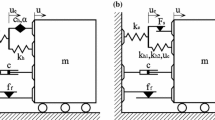Abstract
The recently-developed magnetorheological elastomer (MRE) base isolator can provide an instant change in the shear modulus and damping property under applied magnetic field, which makes it as an ideal device for the semi-active control in buildings and bridges. Previous studies show that this new device is featured with its nonlinear and hysteretic responses, and it is necessary to sufficiently understand its behaviour when adopting this device in control system. Although there are several models presented to predict the hysteresis of MRE base isolator, they are always suffered from some application limitations, e.g. high computation demand or complex model. To better interpret this complicated feature of the device, this work presents an improved LuGre friction model, which has been successfully used in modelling other magnetorheological device i.e. MR damper. In addition, an improved fruit fly optimization algorithm (IFFOA) is also proposed to identify the model parameters. In the improved algorithm, a transfer factor based on a self-adaptive step is added together with a three-dimensional searching space. This improvement can enhance the convergence rate of the algorithm and avoid the local optimum. Furthermore, to reduce the complexity of the model, the local and global parameter sensitivity analyses are conducted for model simplification. Eventually, the experimental measurements of device displacement, velocity and shear force are used to evaluate the performance of the proposed model and IFFOA.



















Similar content being viewed by others
References
Li Y, Li J, Li W, Samali B (2013) Development and characterization of a magnetorheological elastomer based adaptive seismic isolator. Smart Mater Struct 22:035005
Li J, Li Y, Li W, Samali B (2013) Development of adaptive seismic isolators for ultimate seismic protection of civil structures. In: Proceedings of sensors and smart structures technologies for civil, mechanical and aerospace systems, San Diego, USA, 10–14 March 2013, 86920H
Berhrooz M, Wang X, Gordaninejad F (2014) Performance of a new magnetorheological elastomer isolation systems. Smart Mater Struct 23:045014
Behrooz M, Wang X, Gordaninejad F (2014) Modeling of a new semi-active/passive magnetorheological elastomer isolator. Smart Mater Struct 23:045013
Yang J, Du H, Li W, Li Y, Li J, Sun S, Deng HX (2013) Experimental study and modeling of a novel magnetorheological elastomer isolator. Smart Mater Struct 22:117001
Li Y, Li J (2014) A highly-adjustable base isolator utilizing magnetorheological elastomer: experimental testing and modeling. J Vib Acoust. 137:011009
Yu Y, Li Y, Li J (2014) Nonparametric modeling of magnetorheological elastomer base isolator based on artificial neural network optimized by ant colony algorithm. J Intel Mater Syst Struct. doi:10.1177/1045389X15577649
Perera R, Fang S-E, Ruiz A (2010) Application of particle swarm optimization and genetic algorithms to multiobjective damage identification inverse problems with modelling errors. Meccanica 45:732–734
Yu Y, Li Y, Li J (2014) Parameter identification of an improved Dahl model for magnetorheological elastomer base isolator based on enhanced genetic algorithm. In: Proceedings of 23rd Australasian conference on the mechanics of structures and materials, Byron Bay, Australia, 9–12 December 2014, pp 931–936
Yu Y, Li Y, Li J (2014) Parameter identification of a novel strain stiffening model for magnetorheological elastomer base isolator utilizing enhanced particle swarm optimization. J Intel Mater Syst Struct. doi:10.1177/1045389X14556166
Pan W-S (2012) A new fruit fly optimization algorithm: tracking the financial distress model as an example. Knowl-Based Syst 26:69–74
Li C, Xu S, Li W, Hu L (2012) A novel modified fly optimization algorithm for designing the self-tuning proportional integral derivative controller. J Converg Inf Technol 7:69–77
Li H, Guo S, Zhao H, Su C, Wang B (2012) Annual electric load forecasting by a least squares support vector machine with a fruit fly optimization algorithm. Energies 5:4430–4445
Lin SM (2013) Analysis of service satisfaction in web auction logistics service using a combination of fruit fly optimization algorithm and general regression neural network. Neural Comput Appl 22:783–791
Braghin F, Cheli F, Melzi S, Resta F (2006) Tyre wear model: validation and sensitivity analysis. Meccanica 41:143–156
Harmby DM (1994) A review of techniques for parameter sensitivity analysis of environmental models. Environ Monit Assess 32:135–154
Jimenez R, Alvarez-I L (2005) LuGre friction model for a magnetorheological damper. Struct Control Health Monit 12:90–116
Yang F, Sedaghati R, Esmailzadeh E (2009) Development of LuGre friction model for large-scale magneto–rheological fluid dampers. J Intel Mater Syst Struct 20:923–937
Piatkowski T (2014) Dahl and LuGre dynamic friction models—the analysis of selected properties. Mech Mach Theory 73:91–100
Li Y, Li J, Tian T, Li W (2013) A highly adjustable magnetorheological elastomer base isolator for applications of real-time adaptive control. Smart Mater Struct 22:095020
Author information
Authors and Affiliations
Corresponding author
Rights and permissions
About this article
Cite this article
Yu, Y., Li, Y. & Li, J. Parameter identification and sensitivity analysis of an improved LuGre friction model for magnetorheological elastomer base isolator. Meccanica 50, 2691–2707 (2015). https://doi.org/10.1007/s11012-015-0179-z
Received:
Accepted:
Published:
Issue Date:
DOI: https://doi.org/10.1007/s11012-015-0179-z




